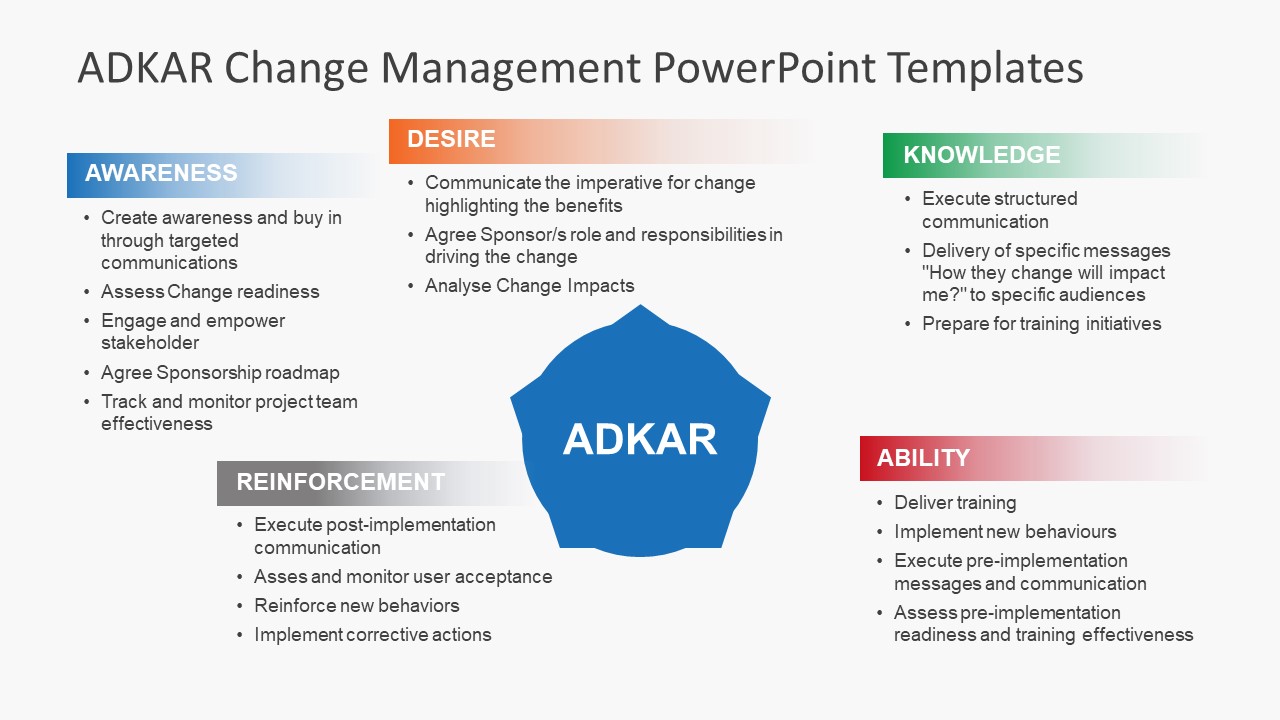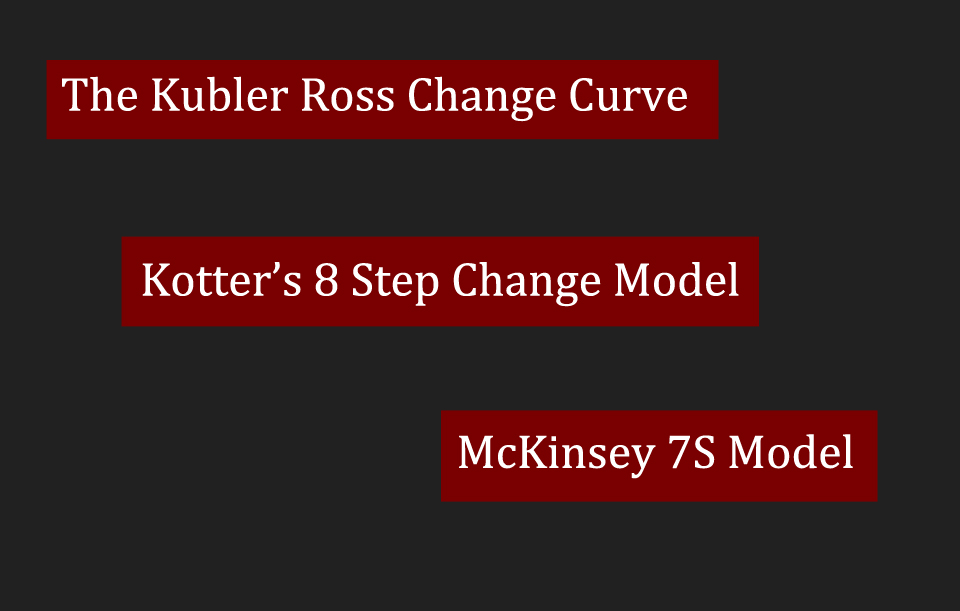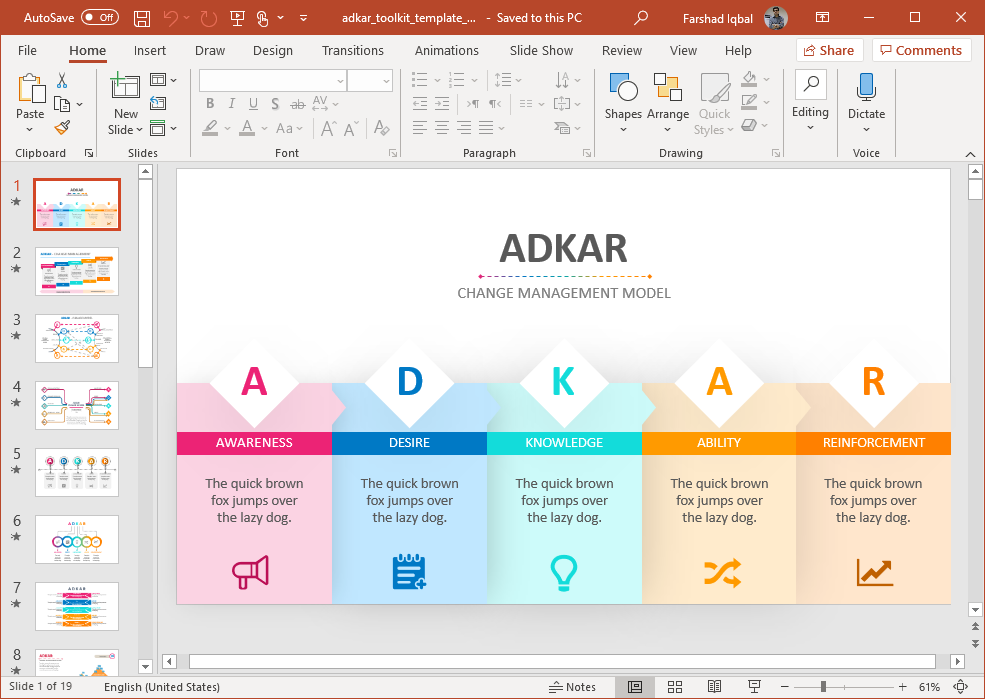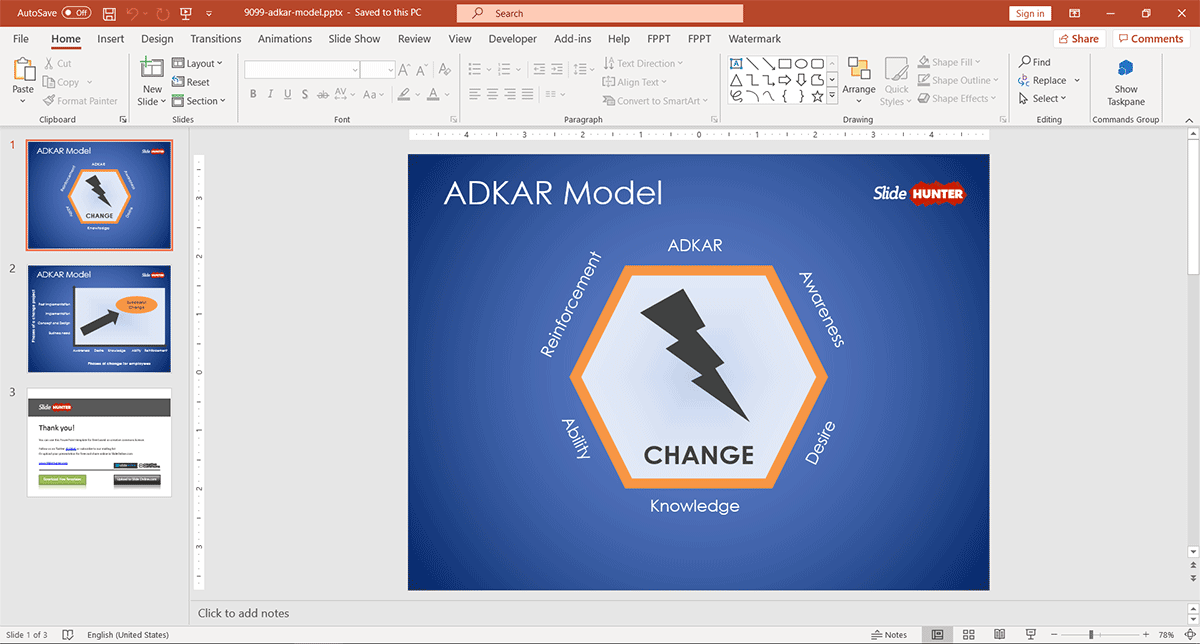ADKAR Change Management Model and ADKAR PowerPoint Templates
One of the most challenging obstacles for any organization is a transition or change that is to be enforced across a department or the entire organization. People can be resistant to change, and employees can revolt by showing active or passive dissent. This is why Change Management (CM) plays an important role to prepare organizations for change. One of the most famous Change Management models is ADKAR, which stands for Awareness, Desire, Knowledge, Ability and Reinforcement.
What is ADKAR Change Management Model?
Introduced by Jeff Hiatt, ADKAR (Awareness, Desire, Knowledge, Ability and Reinforcement) is a Change Management model to help assist employees to guide them through the process of change within an organization. ADKAR is meant to help organizations make sensible changes, identify the associated challenges and plan for the success of such changes.

Source: ADKAR Change Management PowerPoint template by SlideModel
Key Elements of ADKAR
Let’s take a look at how the five key elements of ADKAR, i.e. Awareness, Desire, Knowledge, Ability and Reinforcement, help organizations manage change. These are sequential elements which are meant to help organizations in bringing about the smooth transition or change that is required in an organization.
Awareness
This entails ensuring that employees are made aware for the need for change. For example, an organization might face changes after a merger or there might be a need to introduce better processes, methods or technology in an organization for improving productivity. This might be resisted by employees who are used to old methods, and therefore, it is important to ensure they can understand why the change is necessary.
Desire
Employees must have the desire to be a part of the change. By raising awareness among employees and assuring them that the change is necessary, a desire can be created among employees to participate in the enforcement of the change.
Knowledge
With knowledge regarding the change, employees can better understand the reason for the change and how might it be beneficial for the organization. Obscurity can be a great hindrance and can lead to conspiracies and banter which may affect organizational policies in a negative manner. Knowledge is therefore a key step towards making employees receptive towards the change.
Ability
The transition phase requires that employees have the ability to move through the transition. They must learn new skills and manage their behavior in order to be a part of the change.
Reinforcement
This requires ensuring that employees understand that the change is not going to be reversed. Reinforcement implies sustaining the change.
Source: ADKAR Change Management PowerPoint template by SlideModel
How is ADKAR Used?
The first two elements, i.e. Awareness and Desire are ‘current’, whereas Knowledge and Ability are a part of the ‘transition’ phase and Reinforcement is the phase that is to be applied in the ‘future’. The 5-step ADKAR framework aims at dealing with people regarding the change that is to be implemented. For this purpose, the organization must increase awareness and create a desire among employees to accept the change. This can be done through various sessions, presentations, and meetings. The next phase requires increasing the knowledge of employees and giving them the necessary trainings for allowing them to be able enough to enforce the change.
The last is its reinforcement, which can be done via managers and supervisors to ensure that the change is reinforced. There might be a need for a carrot and stick approach to reward employees that comply and to penalize the ones who might be trouble-mongers. Resistance to change and the mindset to revert changes can be quite strong in employees, especially ones who are old fashioned, with a rusty skill set. Therefore, manager and supervisors might need to be strict with individuals who might seek to sabotage the process. In fact, many employees often loose their job after a radical change since they fail to keep up with the changing environment or are too rigid to look ahead.
Source: ADKAR Change Management PowerPoint template by SlideModel
ADKAR Alternatives
There are also various other Change Management models which can be deemed as an alternative to ADKAR.
The McKinsey 7S Model
The McKinsey 7S Model was developed during the 80s by McKinsey and Company. The model highlights the need for assessing every component by the leaders of an organization before opting for change. The model consists of seven primary factors including; strategy, structure, systems, shared values, style, staff and skills.
Kotter’s 8 Step Change Model
This model was developed by a Harvard University professor by the name of John Kotte. This eight-step change model was developed after he analyzed 100 transitions within organizations. The model provides a sequence of steps for successful transition including; creating a sense of urgency, building a core coalition, developing a strategic vision, involving everyone in the plan, reducing obstacles, focusing on short-term wins, keeping the momentum going and adding some stability.
The Kubler Ross Change Curve
This is quite a unique model since it was developed by a psychiatrist Elisabeth Kubler-Ross for the five stages of grief. This was later translated into business terms for using the five stages as a transitionary phase for employees in an organization. The model discusses the five stages employees will go through during change and should be guided in those stages. These stages include; denial, anger, bargaining, depression and acceptance.

Best ADKAR PowerPoint Templates
If you’re looking to create a presentation regarding ADKAR, here are some professionally designed ADKAR PowerPoint Templates which can help you in creating presentations to showcase the entire 5-step framework.
ADKAR Change Management PowerPoint Template
This premium presentation template by SlideModel provides editable ADKAR slides which can help demonstrate the 5-step framework with great precision. You can show the entire model as a summary and also focus on each of the five key elements of ADKAR using individual slides.
Go to ADKAR Change Management PowerPoint Template
Source: ADKAR Change Management PowerPoint template by SlideModel
Animated ADKAR PowerPoint Template
If you’re looking to create an animated presentation on ADKAR, you can use this template for creating simple to complex slides on the framework. The template contains slides with editable diagrams and infographics which can be quite helpful for explaining the model itself or the change you are looking to bring in your organization.
Go to Presenter Media – Animated ADKAR PowerPoint Template
Free ADKAR Model PowerPoint Template
This free ADKAR Model PowerPoint Template provides space for adding the 5-step framework in the form of a graph, further dividing the ADKAR model in phases including; business need, concept and design, implementation and post-implementation. This is similar to the idea of viewing ADKAR in phases for preparing, designing, implementing and sustaining a project for successful change. You can customize this template to create an ADKAR graph or diagram.
Go to Download Free ADKAR Model PowerPoint Template
Final Words
Change occurs not as an event but a process. This is also the basis of Prosci’s ADKAR model. The current, transition and future phase of the model provides a framework which can be quite effective in enforcing change within an organization. Explaining the process of change can be easier in the form of a presentation. You can download ADKAR PowerPoint Templates to use for explaining the change that you are about to undertake in your organization, with the aid of easy to edit slide designs via the link below.
We will send you our curated collections to your email weekly. No spam, promise!





